A list of Guan, Jin, and other headwear
*This message is here to indicate that this page is still under construction. It will be gone when the article is complete.*
As explained on the previous page, Guan and Jin are both headgear (usually for men) which covers covers the topknot of hair, forehead, or the entire top of the head, and are differentiated by the material and make of the piece itself.
All diagrams are labelled numerically. The decimal proceding indicates the specific style in the image, counting from left to right.
A Source document of this page, more can be found here.
Guan
*NOTE: These Guan styles denoting status and function apply only until around the Tang/Song era, when Jin and Putou take over in popularity. However, the term “Guan” still retains the idea that these are headdresses and caps for officials of status.
All Guans have several key and shared components:
- Zhantong 展筒: “Display Tube”, the “front face” of most Guan, and has ridges or other decor ingrained, etched, or sewn on it.
- Yanti 顏題: “Face Accentuation”, the bottom band of the Guan, decorated with jade, precious gem, or sewn pattern.
- Er 耳: “Ears”, the “perks” at the very back of a Guan, rising up from the Yanti.
- Hong 紘: “Strings”, the sash that begins from the two sides of the Guan and goes down the face (behind the ears) and tied under the chin. Used for stabilizing the headwear and aesthetic effect.
Guan can cover either the full top of the head or just the topknot. The Xiao Guan 小冠 (small Guan, fig.1.1) can come in various shapes, as long as it is the size fitting to that of a topknot. Since the Xiaoguan is an informal Guan, it is not recommended to be worn in the Imperial Court (or otherwise formal situations today), but was somewhat accepted due to its ubiquity.
The Xiezhi Guan 獬豸冠 (fig.1.2) is a Guan style for judges. The Xiezhi is an abstraction for the fabled goat which can determine straight things from warped, hence is a fitting symbology for judges. Commonly used during Qin Dynasty and prior.
The Jinxian Guan 進賢冠 (fig.1.3) is a formal court Guan for civil servants. The ridges on top denote rank of the person, with the more the higher. It can be lined inside with a Jin or Ze. Those without ridges or the Ze frame are commonly worn by Confucian scholars.
The He Guan 鶡冠 (fig.1.4) is a formal court Guan for martial servants. The top of the Guan is adorned with a panache made of a crossbill (he)’s feathers to symbolize bravery. Commonly used by martial and military servants during the Pre-Qin period, Qin, and Han Dynasties. The record Han Gongyi <漢宮儀>records that the Huben Guan 虎賁冠 has two crossbill feathers (one on each side), and Qinjing <禽經> records “The He Guan is worn by military men, to symbolize their bravery”.
The Gaoshan Guan 高山冠 (fig.2.1) is a Guan worn by ministers of external imperial affairs (謁者, also called Pu Ye 僕射, the head minister of the Department of State Affairs). Its shape is squared and has a “mountain” (shan, the central decoration) rising tall and straight. Han Zhi 漢志 records: “peaks but does not retreat in decline. Has a mountain[eous feature], has a Zhantong (展筒 lit. “display tube”, the frontal display portion where decor or ridges are displayed)
The Weimao Guan 委貌冠 (fig.2.2) is the court Guan worn by Zhuhou, or the various lords and high officials. Wei stands for stability, and Mao is proper face, meaning the Way of Rites and Ritual. Its shape is circular, tilted, with the back higher than the front. According to the Shuwu Yiming Shu 庶物異名疏: “Length 7 cun and height 4 cun, it is shaped like an upturned cup. Its front is tall and wide, and its back humble and sharp”. The Book of Han in the chapter Li Yi Dian: “Weimao Guan, also called Pibian Guan 皮弁冠. Zhou [Dynasty] standard. Length …[same as previous]”.
The Yuanyou Guan 遠遊冠 (fig.2.3) is a semi-formal Guan worn by royalty and nobility. Has a Zhantong, and is usually adorned with three ridges. Sometimes it is lined with a black Jie Ze (See later) as decor. It is squareish, tilting back, with an encircling edge that closes at the back. According to The Books of Jin <晉書>: “No mountain at front, has Zhantong in front of the Guan”.
The Liang Guan (Ridged Guan) 梁冠 (fig. 2.4) is the standard court Guan of civil servants across all Han Chinese dynasties. According to the Ming text Sancai Tuhui 三才圖會, it is squarish, with the front lower than the back, tilting slightly backwards, has an enclosing edge, with an open front and a closed back, and is ridged according to statuses as follows: 7 ridges for First Rank, 6 ridges for Second Rank, 5 ridges for Third Rank, 4 ridges for Fourth Rank, 3 ridges for Fifth Rank, 2 ridges for Sixth AND Seventh Rank, 1 ridge for Eighth Rank AND Ninth Rank. Sacrifice rituals using Liang Guan today vary in its ridge usage, from insitution-sanctioned events using up to 5 ridges, or no ridges denoting a strictly civilian affair. This Guan is a direct descendent of the Jinxian Guan, and some may call this Guan by that name.
Official and state rituals of utmost importance (usually involving sacrifices to Heaven) will involve in the usage of the Mian Guan 冕冠 (fig.3.3). The “Mian” refers to the lacquered board placed on top of a Guan (usually is a large Guan that covers the entire head), with a square edge at the back and rounded edge in front. Strands of jade beads called liu 旒 drape from the two ends, with their colours in the respective color order: White (metal), yellow (earth), green (wood), red (fire), black (water). The Emperor’s Mian exclusively uses 12 strands of 12 jade beads front and back, while members of the royalty are entitled to use 9 strands of 9 beads. High and middle-rank officials also can use similar designs with 7 or 5 strands of the same number of beads. There is also a large broad sash that flows to the side, down to the knee, and back up to the other side of the Mian called Tianhe Dai 天河帶 (lit. “Celestial River Band”) that represents the Milky Way. A variation to the Tianhe Dai is a red cord called Shou 綬 which drapes similarly, but does not loop around at the bottom. (See: Sanli Tu, and Book of Han: Li Yi Dian)
The Feng Guan 鳳冠, or the Phoenix Crown (fig.3.2), is a general term for the elaborate formal Guan worn by females of status. The image shown is of Ming standards. The Empress’s Guan is adorned with 9 dragons and 4 phoenixes, and 12 large and 12 small flowers. This Guan style is often reproduced today for Chinese wedding ceremonies.
Jin
Jin are caps of civilian usage. Jin with the use of frames can also be called Ze (幘), and are deemed more formal than the unframed ones. However, there has been mixed use of vocabulary and the two terms are generally interchangeable today.
Headcloths wrapping the head and topknot fall into the Jin category, and unframed ones are called since the Middle Ages “Pu’tou 幞頭“. It is fastened with an attached cloth sash that wraps around the top knot, and can be fastened to the back (fig.4.1) or in front (fig. 4.2).
This cloth sash can be starched or framed up to become stiff, and various styles of presenting the “wings” have been the talk of vogue throughout the ages, from the common down-outward presentation seen since the Han dynasty (fig.4.3) to the “twist up” incident by Guo Tai 郭太 (courtesy name Linzong 林宗) the Eastern Han dynasty, various attempts and interpretations throughout the ages caused the evolution and creation of various Jin with broad, extended flaps. Because of the formalization of this once civilian headwear into a cap of officials with the extending of the flaps, it eventually became a “Guan” in name, such as the Shanyi Guan 善翼冠 (fig.3.1) in the Ming Dynasty, a casual cap for royalty and even the Emperor.
These headcloths can be tailored and worn in different ways to represent different professions. For example, the commoner or a person in the comforts of home can wear a simple Zi Man 緇縵, or simply referred as “headcloth” Tou Jin 頭巾 (fig.5.1), while a Confucian scholar wears a black headcloth with broad neck protection called Fu Jin 幅巾 (fig.5.2) with a Zhuzi Shenyi. City runners and labourers can adorn their hats with a sleek and simple tied headcloth Jie Jin 結巾 (fig.5.3), while the old and rich tend to adorn their headcloths with gold bands and jade features, like the Lei Jin 雷巾 (fig.5.4).
Meanwhile, by the Middle Ages (Tang-Song), the rise of a civilian elite no longer living solely under the aspiration of court service began forming a middle-class aesthetic, and so the civilian headgear evolved accordingly. Made out of materials fit for a civilian, in black cloth or gauze, but achieving tall shapes like a Guan, while retaining the comfort and ease of wearing a soft Jin or cap (Mao). While formed shape headgear made of cloth existed before the middle ages (known as Ze), such as the “Jie (介)” shaped top Ze 介頂幘 (fig. 6.3) or the flat-top Ze 平頂幘 (fig.6.4), it served the purpose of covering the top of the otherwise open-air Guan designs, as lining “underwear” of sorts for the head.
Zhan/Chai


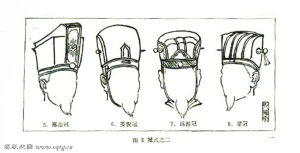
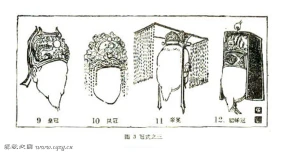
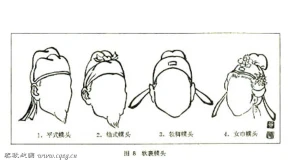

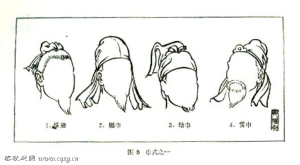
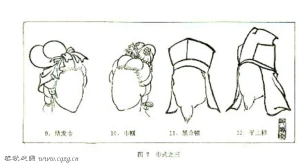



Nov 17, 2009 @ 20:16:32
Am interested in Hanfu Movement as well. Any sources of quality modern manufacturers of the above styles? Would like to order some. Keep up the good work and stay in touch.
Nov 18, 2009 @ 13:39:32
Most Hanfu shops make Rujin and Piaojin now. Dongbo Jin is a bit troublesome to send overseas because it cannot be folded, pressed, or flattened. Same goes for all Guan, unless you want them to come in disassembled and you put it back together yourself (IMPOSSIBLE unless ceremonial Liang Guan). Last time I checked, these accessories are about $10 (80RMB) each, but the transport costs to N. America would probably be 10x that…
In most e-shops, look under 首服頭飾, or something like that
Mar 15, 2010 @ 00:47:43
great information you have here! its hard to find this kind of info so i really appreciate it. although women didn’t wear headgear, is it possible if you could show or tell what kind of ornaments they put in their hair? or what exactly are the kinds of hair styles they did? of course i see the wuxia tv dramas but sometimes i wonder what the girls really looked like in the old days because some of the tv drama hairstyles on the girls looked quite impossible….
Mar 29, 2010 @ 09:08:09
Hello, i am very glad to read this passage.
May i if it is possible to have the Chinese version of this passage. Thank you so much if you can send it to me.
I love traditional Chinese culture including Hanfu. It’s nice to meet you through your article.
Apr 10, 2010 @ 16:34:15
Hello Lincoln!
Gao Chunming 高春明 did most of the artwork and research here. His book “5000 years of Chinese Costumes” was the authority on studying Chinese clothing (including Hanfu), along with Shen Congwen 沈從文.
http://www.amazon.com/5000-Years-Chinese-Costumes-Zhou/dp/0835118223 <– There's even an english version.
However, his works are over 20 years old, and there are several details Gao wrote which have been disproven / found to be a mistake by Hanfu researchers today (e.g. how the Quju works and which way it spun around in his drawings).
The Hanfu Movement differs from this same subject in academia in terms of classifying the clothes itself – the latter field tends to use period and by-case examples, whereas the former (us) use a practical by-design basis, without as much focus on the period element.
Jun 24, 2013 @ 14:07:55
I don’t know much about there but It seems I cannot find much material/pictures on ‘gaoshanguan’ and the 12th image, the headwear to the right of the Mian Guan.
Besides, is there any information about those guan with red “flame-shaped” tufts??
I’ve seen some depictions, such as Lu Bu, dong zhuo and other officials with these, and I can’t find much on them.
Nov 24, 2014 @ 11:22:27
I was looking for headgear documentation.
Thanks a lot!
Nov 15, 2016 @ 08:54:15
please to complete this article and add the source too, im looking forward for it
thank you!
Apr 13, 2017 @ 10:25:44
Meanwhile, by the Middle Ages (Tang-Song), the rise of a civilian elite no longer living solely under the aspiration of court service began forming a middle-class aesthetic, and so the civilian headgear evolved accordingly. Made out of materials fit for a civilian, in black cloth or gauze, but achieving tall shapes like a Guan, while retaining the comfort and ease of wearing a soft Jin or cap (Mao). While formed shape headgear made of cloth existed before the middle ages (known as Ze), such as the “Jie (介)” shaped top Ze 介頂幘 (fig. 6.3)
——————————————————————————-
A wonderful find –
Would you be able to refer sources of further information regards – Jie (介)” shaped top Ze 介頂幘 (fig. 6.3)
Dec 06, 2019 @ 10:56:13
Many thanks for your very helpful and informative site. I’m translating a novel from Hebrew to English. The writer visited Nanshe, China, some 15 years ago, was fascinated, returned several times, took notes, then included a couple of chapters in his novel that take place in Nanshe (in the form of a dream.) Anyway, he describes the Eight Immortals, and two of them are wearing a Jin. I had no idea how to translate it or what it was.
Dec 15, 2019 @ 15:47:04
I have an ancestor portrait that recalls a jingbiao done ca 1637 in which the people wear black caps of a sort unknown to me. Both wear elegant black caps (futou [襆頭] or wushamao [烏紗帽]?); hers adorned with a single jewel, his with a single jade-like ornament. The caps appear to be crowned with a simple gold edge in her case, and his with a black structure in his. I am interested in identifying this type of hat and can provide pictures.
Nov 12, 2020 @ 22:38:59
If I send you a photo of a lady with a headdress on her can you tell me what kind of headdress it is?
Feb 19, 2021 @ 10:08:58
Thank you so much for this information. We were watching the Netflix “100 Days of the Crown Prince” and just loved their headgear. This explains a lot! So appreciate this website.
May 19, 2021 @ 14:04:36
To add to my comment on Dec. 15, 2019. Her headdress above the cap is a crown with three pearls and his is topped with a structure in the shape of a bat. She received a jingbiao and he died while young.